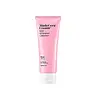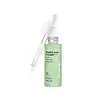What's inside
What's inside
 Key Ingredients
Key Ingredients

 Benefits
Benefits

 Concerns
Concerns

 Ingredients Side-by-side
Ingredients Side-by-side

Sea Water
HumectantGlycerin
HumectantMyristic Acid
CleansingWater
Skin ConditioningPalmitic Acid
EmollientPotassium Hydroxide
BufferingLauric Acid
CleansingGlyceryl Stearate
Emollient1,2-Hexanediol
Skin ConditioningPotassium Cocoyl Glycinate
Hydrolyzed Collagen
EmollientOlea Europaea Fruit Oil
MaskingButyrospermum Parkii Butter
Skin ConditioningSqualane
EmollientCeramide NP
Skin ConditioningAlanine
MaskingSerine
MaskingPCA
HumectantDipropylene Glycol
HumectantCholesterol
EmollientAsiaticoside
AntioxidantMadecassic Acid
Skin ConditioningPhytosphingosine
Skin ConditioningAsiatic Acid
Skin ConditioningMadecassoside
AntioxidantPortulaca Oleracea Extract
Skin ConditioningTilia Europaea Flower Extract
Skin ConditioningHamamelis Virginiana Extract
AntiseborrhoeicCitrus Aurantium Dulcis Peel Oil
MaskingPelargonium Graveolens Flower Oil
MaskingRosmarinus Officinalis Leaf Extract
AntimicrobialViola Odorata Flower Extract
MaskingAbelmoschus Esculentus Fruit Extract
Skin ConditioningAloe Barbadensis Leaf Extract
EmollientUlmus Davidiana Root Extract
Skin ConditioningAlgae Oligosaccharides
Skin ConditioningCitrus Limon Peel Oil
MaskingStearic Acid
CleansingPolyquaternium-7
Disodium EDTA
Sodium Benzoate
MaskingButylene Glycol
HumectantCapric Acid
CleansingHydrogenated Lecithin
EmulsifyingCaprylic/Capric Triglyceride
MaskingCitronellol
PerfumingLimonene
PerfumingSea Water, Glycerin, Myristic Acid, Water, Palmitic Acid, Potassium Hydroxide, Lauric Acid, Glyceryl Stearate, 1,2-Hexanediol, Potassium Cocoyl Glycinate, Hydrolyzed Collagen, Olea Europaea Fruit Oil, Butyrospermum Parkii Butter, Squalane, Ceramide NP, Alanine, Serine, PCA, Dipropylene Glycol, Cholesterol, Asiaticoside, Madecassic Acid, Phytosphingosine, Asiatic Acid, Madecassoside, Portulaca Oleracea Extract, Tilia Europaea Flower Extract, Hamamelis Virginiana Extract, Citrus Aurantium Dulcis Peel Oil, Pelargonium Graveolens Flower Oil, Rosmarinus Officinalis Leaf Extract, Viola Odorata Flower Extract, Abelmoschus Esculentus Fruit Extract, Aloe Barbadensis Leaf Extract, Ulmus Davidiana Root Extract, Algae Oligosaccharides, Citrus Limon Peel Oil, Stearic Acid, Polyquaternium-7, Disodium EDTA, Sodium Benzoate, Butylene Glycol, Capric Acid, Hydrogenated Lecithin, Caprylic/Capric Triglyceride, Citronellol, Limonene
Water
Skin ConditioningAlcohol
AntimicrobialButylene Glycol
HumectantDipropylene Glycol
HumectantPropanediol
Solvent1,2-Hexanediol
Skin ConditioningBetaine
HumectantGlycerin
HumectantAsiaticoside
AntioxidantMadecassoside
AntioxidantMelaleuca Alternifolia Leaf Extract
PerfumingWasabia Japonica Root Extract
Skin ConditioningCeramide NP
Skin ConditioningBiosaccharide Gum-1
HumectantAloe Barbadensis Flower Extract
EmollientAloe Barbadensis Leaf Extract
EmollientCentella Asiatica Extract
CleansingCitrus Aurantium Bergamia Fruit Oil
MaskingCoccinia Indica Fruit Extract
Skin ConditioningCorallina Officinalis Extract
Skin ConditioningCryptomeria Japonica Leaf Extract
HumectantCurcuma Longa Root Extract
MaskingDioscorea Japonica Root Extract
Skin ConditioningHouttuynia Cordata Extract
Skin ConditioningLactobacillus Ferment
Skin ConditioningLaminaria Japonica Extract
Skin ProtectingLavandula Angustifolia Oil
MaskingMelia Azadirachta Flower Extract
Skin ConditioningMelia Azadirachta Leaf Extract
Skin ConditioningNelumbo Nucifera Leaf Extract
Skin ConditioningOcimum Sanctum Leaf Extract
Skin ConditioningSaccharomyces Ferment
Skin ConditioningSalvia Officinalis Oil
MaskingSolanum Melongena Fruit Extract
Skin ConditioningTilia Europaea Flower Extract
Skin ConditioningUlmus Davidiana Root Extract
Skin ConditioningViola Mandshurica Flower Extract
AntioxidantHydrogenated Lecithin
EmulsifyingXanthan Gum
EmulsifyingMethyl Gluceth-10
EmulsifyingPolyglyceryl-10 Laurate
Skin ConditioningAcrylates/C10-30 Alkyl Acrylate Crosspolymer
Emulsion StabilisingTromethamine
BufferingGlyceryl Stearate
EmollientEthylhexylglycerin
Skin ConditioningDenatonium Benzoate
MaskingLimonene
PerfumingLinalool
PerfumingWater, Alcohol, Butylene Glycol, Dipropylene Glycol, Propanediol, 1,2-Hexanediol, Betaine, Glycerin, Asiaticoside, Madecassoside, Melaleuca Alternifolia Leaf Extract, Wasabia Japonica Root Extract, Ceramide NP, Biosaccharide Gum-1, Aloe Barbadensis Flower Extract, Aloe Barbadensis Leaf Extract, Centella Asiatica Extract, Citrus Aurantium Bergamia Fruit Oil, Coccinia Indica Fruit Extract, Corallina Officinalis Extract, Cryptomeria Japonica Leaf Extract, Curcuma Longa Root Extract, Dioscorea Japonica Root Extract, Houttuynia Cordata Extract, Lactobacillus Ferment, Laminaria Japonica Extract, Lavandula Angustifolia Oil, Melia Azadirachta Flower Extract, Melia Azadirachta Leaf Extract, Nelumbo Nucifera Leaf Extract, Ocimum Sanctum Leaf Extract, Saccharomyces Ferment, Salvia Officinalis Oil, Solanum Melongena Fruit Extract, Tilia Europaea Flower Extract, Ulmus Davidiana Root Extract, Viola Mandshurica Flower Extract, Hydrogenated Lecithin, Xanthan Gum, Methyl Gluceth-10, Polyglyceryl-10 Laurate, Acrylates/C10-30 Alkyl Acrylate Crosspolymer, Tromethamine, Glyceryl Stearate, Ethylhexylglycerin, Denatonium Benzoate, Limonene, Linalool
Ingredients Explained
These ingredients are found in both products.
Ingredients higher up in an ingredient list are typically present in a larger amount.
1,2-Hexanediol is a synthetic liquid and another multi-functional powerhouse.
It is a:
- Humectant, drawing moisture into the skin
- Emollient, helping to soften skin
- Solvent, dispersing and stabilizing formulas
- Preservative booster, enhancing the antimicrobial activity of other preservatives
Aloe Barbadensis Leaf Extract is an extract of the leaves of the aloe, Aloe barbadensis, Liliaceae.
Aloe is one of the most well-known natural soothing ingredients, and for good reason. It’s full of water and has a cooling, calming effect on the skin, especially when it’s sunburned, itchy, or irritated. Aloe also helps your skin stay hydrated and smooth by mimicking what healthy skin naturally produces. On top of that, it contains vitamins and nutrients that support skin recovery.
It doesn’t protect you from the sun, but it can help your skin bounce back after too much time in it.
Let’s get into the details:
Aloe contains antioxidant Vitamins A, C, and E, which help fight off free radicals (unstable molecules from things like pollution that can damage your skin).
It’s also rich in polysaccharides, which are natural sugars that help hydrate the skin by acting like the skin’s own moisturizing agents. These, along with other sugars like monosaccharides, help form a protective barrier that locks in moisture.
Aloe works as both a humectant and an emollient. That means it draws water into the skin (humectant) and helps trap it there (emollient), making it an effective natural moisturizer.
You’ll also find a mix of other skin-supporting ingredients in aloe, including folic acid, choline, calcium, amino acids, fatty acids, and even Vitamin B12.
Out of the 420+ species of aloe, Aloe barbadensis is the most widely used in skincare products thanks to its gentle yet effective properties.
There are over 420 species of aloe but Aloe Barbadensis is the most commonly used for topical products.
Learn more about Aloe Barbadensis Leaf ExtractAsiaticoside comes from the super popular skin-soothing ingredient, Centella asiatica. It is one of four active compounds found in the extract of Centella Asiatica.
Asiaticoside is an antioxidant and helps with wound healing. It has been shown to increase antioxidant activity during the wound healing process.
Butylene Glycol (or BG) is used within cosmetic products for a few different reasons:
Overall, Butylene Glycol is a safe and well-rounded ingredient that works well with other ingredients.
Though this ingredient works well with most skin types, some people with sensitive skin may experience a reaction such as allergic rashes, closed comedones, or itchiness.
Learn more about Butylene GlycolCeramide NP is a type of ceramide and formally known as ceramide 3.
Ceramides are intercellular lipids naturally found in our skin that bonds dead skin cells together to create a barrier. They are known for their ability to hold water and thus are a great ingredient for dry skin.
Ceramides are an important building block for our skin barrier. A stronger barrier helps the skin look more firm and hydrated. By bolstering the skin ceramides act as a barrier against irritating ingredients. This can help with inflammation as well.
If you would like to eat ceramides, sweet potatoes contain a small amount.
Read more about other common types of ceramides here:
Ceramide AP
Ceramide EOP
Dipropylene Glycol is a synthetically created humectant, stabilizer, and solvent.
This ingredient helps:
Dipropylene glycol is technically an alcohol, but it belongs to the glycol family (often considered part of the ‘good’ alcohols). This means it is hydrating and gentle on skin unlike drying solvent alcohols like denatured alcohol.
As a masking agent, Dipropylene Glycol can be used to cover the smell of other ingredients. However, it does not have a scent.
Studies show Dipropylene Glycol is considered safe to use in skincare.
Learn more about Dipropylene GlycolGlycerin is already naturally found in your skin. It helps moisturize and protect your skin.
A study from 2016 found glycerin to be more effective as a humectant than AHAs and hyaluronic acid.
As a humectant, it helps the skin stay hydrated by pulling moisture to your skin. The low molecular weight of glycerin allows it to pull moisture into the deeper layers of your skin.
Hydrated skin improves your skin barrier; Your skin barrier helps protect against irritants and bacteria.
Glycerin has also been found to have antimicrobial and antiviral properties. Due to these properties, glycerin is often used in wound and burn treatments.
In cosmetics, glycerin is usually derived from plants such as soybean or palm. However, it can also be sourced from animals, such as tallow or animal fat.
This ingredient is organic, colorless, odorless, and non-toxic.
Glycerin is the name for this ingredient in American English. British English uses Glycerol/Glycerine.
Learn more about GlycerinGlyceryl Stearate is a mix of glycerin and stearic acid.
It is used to stabilize the mixing of water and oil ingredients. By preventing these ingredients from separating, it can help elongate shelf life. It can also help thicken the product's texture.
As an emollient, it helps soften skin and supports barrier-replenishing ingredients.
In cosmetics, Glyceryl Stearate is often made from vegetable oils or synthetically produced.
This ingredient may not be fungal-acne safe
Fun fact: The human body also creates Glyceryl Stearate naturally.
Learn more about Glyceryl StearateHydrogenated Lecithin is created from the hydrogenation of lecithin (a group of phospholipids). Hydrogenation is a chemical reaction between hydrogen and another element.
This ingredient is an emollient and emulsifier. As an emollient, it helps soften skin by trapping moisture within. As an emulsifier, it prevents oil and water ingredients from separating.
Limonene is a fragrance that adds scent and taste to a formulation.
It's found in the peel oil of citrus fruits and other plants such as lavender and eucalyptus. The scent of limonene is generally described as "sweet citrus".
Limonene acts as an antioxidant, meaning it helps neutralize free radicals.
When exposed to air, oxidized limonene may sensitize the skin. Because of this, limonene is often avoided by people with sensitive skin.
The term 'fragrance' is not regulated in many countries. In many cases, it is up to the brand to define this term. For instance, many brands choose to label themselves as "fragrance-free" because they are not using synthetic fragrances. However, their products may still contain ingredients such as essential oils that are considered a fragrance.
Learn more about LimoneneMadecassoside comes from the super popular skin-soothing ingredient, Centella asiatica. It is one of four active compounds found in the extract of Centella Asiatica.
Madecassoside has antioxidant, anti-inflammatory, and hydrating properties. It contains fatty acids, amino acids, beta-carotene, and phytochemicals.
One study found using Madecassoside with ascorbic acid helped reduce the signs of aging and improved skin hydration.
Learn more about MadecassosideWe don't have a description for Tilia Europaea Flower Extract yet.
This tree is also known as the David Elm. It contains the ingredient bakuchiol.
Other great compounds found in this ingredient include galactose, glucose, and phenolics. The sugar content gives it great skin hydrating properties. Phenolics are potent antioxidants commonly found in fruits and veggies.
A 2020 study found the phenolics of this root to have an anti-inflammatory effect.
Fun fact: This ingredient is used in traditional Asian medicine.
Learn more about Ulmus Davidiana Root ExtractWater. It's the most common cosmetic ingredient of all. You'll usually see it at the top of ingredient lists, meaning that it makes up the largest part of the product.
So why is it so popular? Water most often acts as a solvent - this means that it helps dissolve other ingredients into the formulation.
You'll also recognize water as that liquid we all need to stay alive. If you see this, drink a glass of water. Stay hydrated!
Learn more about Water